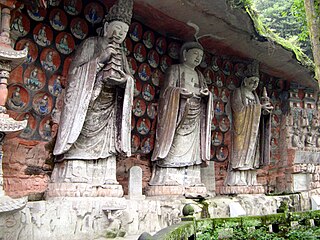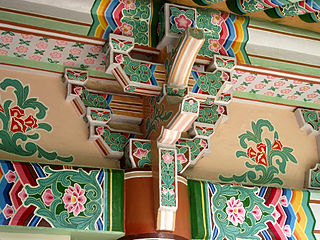
The Huayan school of Buddhism is a Mahayana Buddhist tradition that developed in China during the Tang dynasty (618-907). The Huayan worldview is based primarily on the Buddhāvataṃsaka Sūtra as well as on the works of Huayan patriarchs, like Zhiyan (602–668), Fazang (643–712), Chengguan (738–839), Zongmi (780–841) and Li Tongxuan (635–730).

South Jeolla Province, also known as Jeonnam, is a province in the Honam region, South Korea, and the southernmost province in mainland Korea. South Jeolla borders the provinces of North Jeolla to the north, South Gyeongsang to the northeast, and Jeju to the southwest in the Korea Strait.

Gurye (Gurye-gun) is a county in the province of Jeollanam-do, South Korea. Gurye is a small, picturesque farming town situated between Jirisan and the Seomjin River. In the northeastern part of unwavering efforts at the Mt. Jiri. Gurye is the sole designated special tourism and leisure zone in all of Jeollanam-do. The total size of Gurye County is 443.02 square km, with a modest population of approximately 30,000.
National Treasure (Korean: 국보) is a national-level designation within the heritage preservation system of South Korea for tangible objects of significant artistic, cultural and historical value. Examples of objects include art, artifacts, sites, or buildings. It is administered by the Cultural Heritage Administration (CHA). Additions to the list are decided by the Cultural Heritage Committee.

Korean architecture refers to an architectural style that developed over centuries in Korea. Throughout the history of Korea, various kingdoms and royal dynasties have developed a unique style of architecture with influences from Buddhism and Korean Confucianism.

Beomeosa is one of the head temples of the Jogye Order of Korean Buddhism in Cheongnyeongnopo-dong, Geumjeong District, Busan, South Korea. Built on the slopes of the mountain Geumjeongsan, it is one of the country's best known temples.

Woljeongsa (Korean: 월정사) is a head temple of the Jogye Order of Korean Buddhism, located on the eastern slopes of Odaesan in Pyeongchang County, Gangwon Province, South Korea. Woljeongsa was founded in 643 by the Silla monk Jajang.

Hwaeomsa is a head temple of the Jogye Order of Korean Buddhism. It is located on the slopes of Jirisan, in Masan-myeon, Gurye County, in South Jeolla Province, South Korea.

Geumsansa is a temple of the Jogye Order of Korean Buddhism standing on the slopes of Moaksan in Gimje City, Jeollabuk-do, South Korea.

Dabotap (Korean: 다보탑) is a stone pagoda located in the Buddhist temple of Bulguksa in Gyeongju, South Korea. From entering the temple through the Cheongun and Baegun Bridge, Dabotap is located on the right side, opposing Seokgatap on the left side. The pagoda is supposed to have been built in 751, the 10th year of the Shilla king Gyeongdeok. It is currently designated as National Treasure no. 20.

Wongaksa Pagoda (Korean: 원각사지십층석탑) is a 12 meter tall, ten story marble pagoda located in Tapgol Park, Seoul, South Korea.

Bunhwangsa is a temple complex from the Old Silla era of Korea. It is located in Gyeongju. The temple is recorded to have been built in 634 under the auspices of Queen Seondeok. Today the temple is still used by a small group of worshipers but in its heyday, the temple covered several acres and was one of the four main temples of the Silla Kingdom used by the state to ask the Buddha to bless the kingdom. The ruins of Hwangnyongsa Temple lay nearby. It is part of the UNESCO world heritage site Gyeongju Historic Areas.

Tapgol Park, formerly Pagoda Park, is a public park located at 99 Jongno, Jongno District, Seoul, South Korea. It is 1.50561 ha in area. The park was previously known as Pagoda Park until May 28, 1992.

Shilleuksa is a Korean Buddhist temple situated against a low hill on the north side of the river Namhan, three kilometers east of Yeoju in Gyeonggi Province, approximately one-hour southeast of Seoul. The only riverside temple in South Korea, Shilleuksa is a sacred pilgrimage site and a repository of seven Treasures. A 500-year-old aromatic juniper tree and a 600-year-old ginkgo tree stand on the temple grounds.

Nanchan Temple is a Buddhist temple located near the town of Doucun on Mount Wutai, Shanxi, China. Nanchan Temple was built in 782 during China's Tang dynasty, and its Great Buddha Hall is currently China's oldest preserved timber building extant, as wooden buildings are often prone to fire and various destruction. Not only is Nanchan Temple an important architectural site, but it also contains an original set of artistically important Tang sculptures dating from the period of its construction. Seventeen sculptures share the hall's interior space with a small stone pagoda.

Gakhwangjeon Hall (Korean: 각황전) is a hall of worship at Hwaeomsa, a Buddhist temple in Gurye County, South Jeolla Province, South Korea. It is one of the monastery's two principal halls and overlooks the northwest end of the courtyard. In addition to being one of the largest Buddhist halls in South Korea, Gakhwangjeon Hall is registered as National Treasure 67 by the Cultural Heritage Administration.

Kaiyuan Temple is a Buddhist temple located in West Street, Quanzhou, China, and is considered as the largest Buddhist temple in Fujian province with an area of 78,000 square metres (840,000 sq ft). The central figures of veneration in the temple are the Five Tathāgathas from Chinese Esoteric Buddhism who are enshrined in the temple's Mahavira Hall. In 2021, the temple was inscribed on the UNESCO World Heritage List along with other sites near Quanzhou because of its importance during the medieval global maritime trade based in Quanzhou and its testimony to the global exchange of ideas and cultures. The temple is also one of few in China to contain Hindu monuments, left there by traders from Southern India.

Nengren Temple is a Buddhist temple located in Xunyang District of Jiujiang, Jiangxi, China. Nengren Temple is one of the "Three Buddhist Temples of Jiujiang". It has been authorized as a National Key Buddhist Temple in Han Chinese Area by the State Council of China in 1983. Nengren Temple was first built in the Northern and Southern dynasties (420–589), and went through many changes and repairs through the following dynasties. The modern temple was founded in 1870 in the Tongzhi period of the Qing dynasty (1644–1911).

Huayan Temple or Huayan Monastery is a Buddhist temple located in Datong, Shanxi, China.
Huayan Temple is a Buddhist temple located on Mount Zhiti (支提山), in Jiaocheng District of Ningde, Fujian, China. It is the ashram of the Bodhisattva Ratnakūta (天冠菩薩).


















